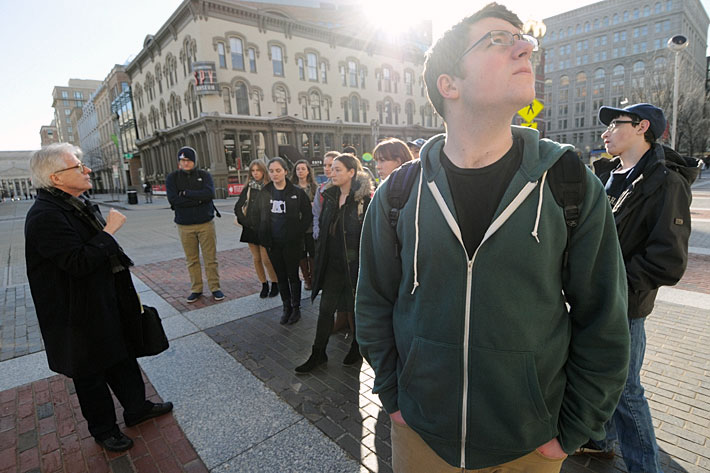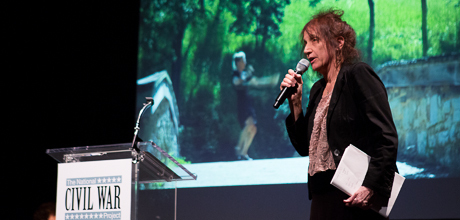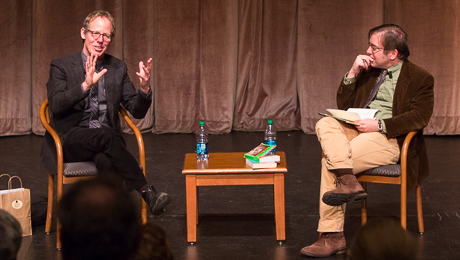By James Irwin
Abraham Lincoln’s heart was still beating as doctors carried him up the stairs and into the Petersen House across the street from Ford’s Theatre. And so the last public sighting of the American president while he still lived was a rushed journey to a boarding house bed chamber for the purpose of dying.
Down the narrow front hallway Lincoln went, and into the rear of the home, where he was placed diagonally on a bed too small for his 6-foot-4 frame. Lincoln lay there for nearly nine hours before his last breath the morning of April 15, 1865.
“It is surprising he lasted that long,” Thomas Mallon, professor of English in the Columbian College of Arts and Sciences, tells his class as it gathers down the hallway from the room where Lincoln died. “It is likely a testament to his strength of constitution that he lived through the night.”
Dr. Mallon and his students are at Ford’s Theatre and the Petersen House, nine blocks east of GW’s Elliott School of International Affairs, on a class trip for his seminar, “The Assassination of Lincoln.” It’s Feb.11, roughly two months before the 150th anniversary of Lincoln’s death.
“It’s one of those classes where we’re learning what happened in the exact place where it happened,” said Camille Kidd, one of 19 freshmen in the class. “We’re going to the place where he was assassinated, the house where he died, the place where the plot was born. It makes it exciting, you kind of live in the moment.”
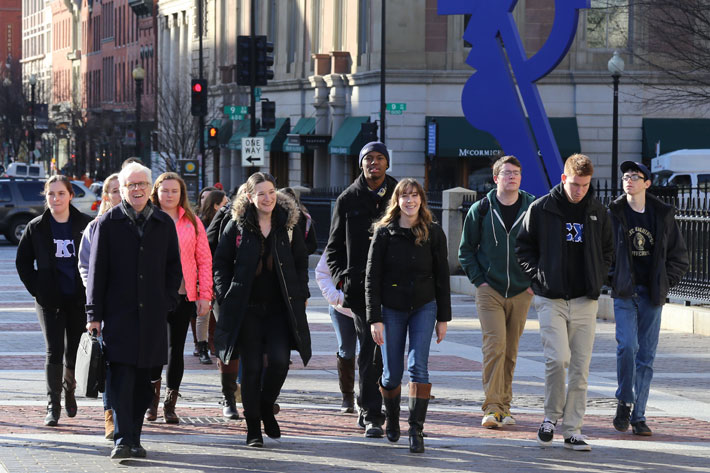 Dr. Mallon leads his class along F Street, in front of the National Portrait Gallery. "This was the heart of downtown in the 1860s," he said. It also was the corridor John Wilkes Booth took on his escape from Washington. (Rob Stewart/GW Today)
Dr. Mallon leads his class along F Street, in front of the National Portrait Gallery. "This was the heart of downtown in the 1860s," he said. It also was the corridor John Wilkes Booth took on his escape from Washington. (Rob Stewart/GW Today)
A ‘kitchen sink course’
An author of historical fiction, Dr. Mallon has taught “The Assassination of Lincoln” on and off since 2004. He approaches the topic as a novelist. The class examines Lincoln’s murder at the hand of actor and Confederate sympathizer John Wilkes Booth and uses the assassination to observe 19th-century American culture. Dr. Mallon, who wrote a novel about the Lincolns’ guests at Ford’s Theatre the night of the assassination, calls “The Assassination of Lincoln” a “kitchen sink course,” that explores the relationship between history, theater, photography, literature, art and architecture.
The Lincoln Memorial, he said, is one of the more obvious examples of how cultural reaction absorbs or warps history. Dedicated in 1922, the memorial celebrates Lincoln as the savior of the Union, but its role as the backdrop to the 1963 March on Washington has caused the symbolism to evolve over time.
“The idea of Lincoln as ‘the Great Emancipator’ and Lincoln as ‘the Great Unifier’ adjusts depending on what’s going on in contemporary society,” Ms. Kidd said. “It makes you think about how history changes.”
What the study of Lincoln’s assassination also provides, Dr. Mallon said, is an opportunity for a fiction writer to go where biographers generally don’t venture: the freedom to climb into the consciousness of a past figure, fill in unknown gaps and pursue “what-if” scenarios. What if Lincoln hadn’t been killed? What if he had led Reconstruction? Who would he have disappointed?
“Mostly I’m interested in the role of character, fate, imagining alternate versions of events—the role of accident,” Dr. Mallon said. “That, I think, encourages students to think of history in a way that is both historical and an exercise in counterfactual history.”
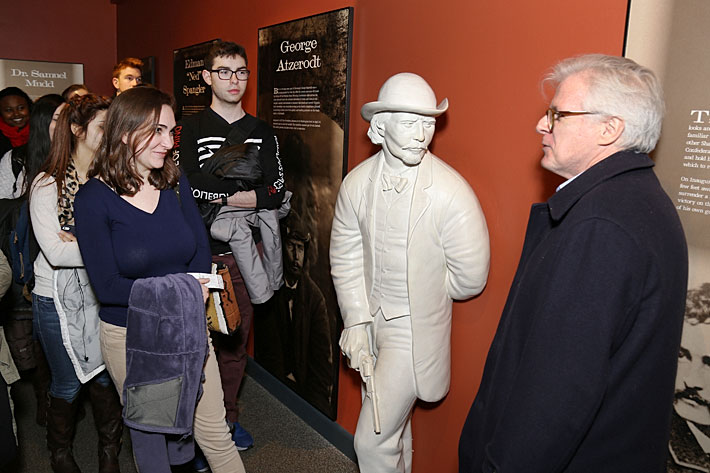 A statue of George Atzerodt stands along the back wall of the Ford's Theatre museum. Atzerodt, a peripheral figure of the Lincoln-Booth narrative, was tasked with the assassination of Vice President Andrew Johnson. He failed to even attempt this act, instead losing his nerve and getting drunk in a bar. That he has a statue in a museum is part of what Dr. Mallon calls the "pageant effect" of history. (Rob Stewart/GW Today)
A statue of George Atzerodt stands along the back wall of the Ford's Theatre museum. Atzerodt, a peripheral figure of the Lincoln-Booth narrative, was tasked with the assassination of Vice President Andrew Johnson. He failed to even attempt this act, instead losing his nerve and getting drunk in a bar. That he has a statue in a museum is part of what Dr. Mallon calls the "pageant effect" of history. (Rob Stewart/GW Today)
Washington: Setting for storytellers
That exercise can be tedious, Dr. Mallon said. Historical accuracy becomes almost more important for a writer planning to inject fiction into the story. The more authenticity you have, he said, the more likely you are to get away with imagination.
“One of my favorite assignments is we had to pretend we were at Ford’s Theatre during the assassination,” said Ms. Kidd. “We looked at 19th-century letter writing, how people communicated with their parents, how a woman would react versus how a man would react. It makes you think of how historical fiction is written. It’s about figuring out how to keep an audience entertained but also making sure it’s believable, that the history is coming through.”
That is a big reason why Dr. Mallon plans the walking tour of downtown, which covers sites along nearly a dozen blocks between Ford’s Theatre, Judiciary Square and Gallery Place. It provides students a glimpse of Lincoln’s Washington that he hopes will bring them closer to the assassination’s principal characters. From Ford’s Theatre, it is a two-block walk to the neo-classical National Portrait Gallery. In 1865, this was the U.S. Patent Office, one of Washington’s landmark government buildings.
Block out the restaurants and video boards from the nearby Verizon Center and the past begins to reveal itself. It’s part of what makes Washington—with its historically preserved buildings wedged between glass offices and apartments—an easier city to peel back chronologically, Dr. Mallon said. The patent office and post office across the street (now the Hotel Monaco) anchored downtown in the 1860s, an area often frequented by Lincoln and Booth, and the corridor Booth took on his escape the night he shot the president.
“It is as close to a block of space as it was in Lincoln’s time as you will see in Washington today,” Dr. Mallon said. “I want to interest students in the physical environment they live in and get them to have a retrospective cast of mind—people who can’t walk down a street in this city without wondering, ‘Who used to live in that building?’”
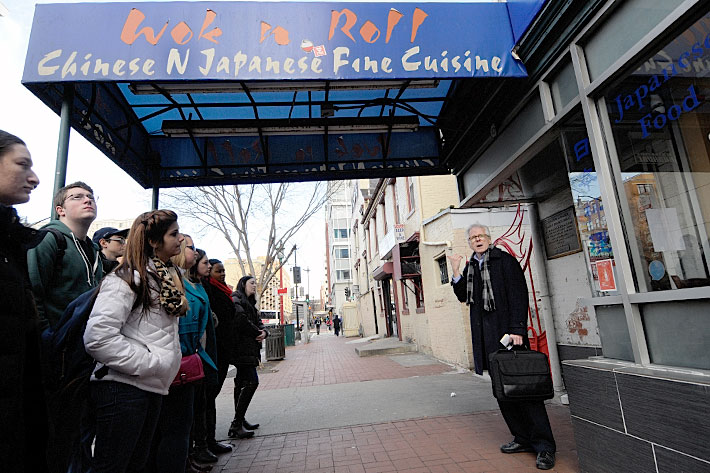 Dr. Mallon introduces his class to one of the most historic buildings in Washington—and one that has been largely forgotten: the Surratt boarding house, where the conspiracy against Lincoln was planned. (Rob Stewart/GW Today)
Dr. Mallon introduces his class to one of the most historic buildings in Washington—and one that has been largely forgotten: the Surratt boarding house, where the conspiracy against Lincoln was planned. (Rob Stewart/GW Today)
Preserving the ‘moral factor’
The Surratt House, a simple, three-story boarding house in the 600 block of H Street Northwest, is perhaps the most intriguing location on the tour. Here, at the front door of the Wok and Roll restaurant, the house where the conspiracy against Lincoln was hatched largely has been forgotten, its role in the assassination marked only by a small plaque to the side of the door. This is one of the most historic buildings in Washington, Dr. Mallon said, and played a much larger part in the assassination narrative than the Petersen House, where Lincoln died.
For Ms. Kidd, a campus tour guide, Lincoln admirer and history enthusiast, “The Assassination of Lincoln” has sparked a special interest in Mary Surratt, the boarding house proprietor. Hanged on July 7, 1865, along with three other Lincoln assassination accomplices, Surratt has received less historical coverage than other co-conspirators. Ms. Kidd is writing a research paper for another class on her trial and how she has been represented in film and literature.
“She is this lost figure in history,” Ms. Kidd said. “The way she is portrayed in movies is this giant ‘what-if’ question because she wasn’t allowed to speak for herself. I think historical fiction helps bring figures in history back to light. It encourages people to look closer.”
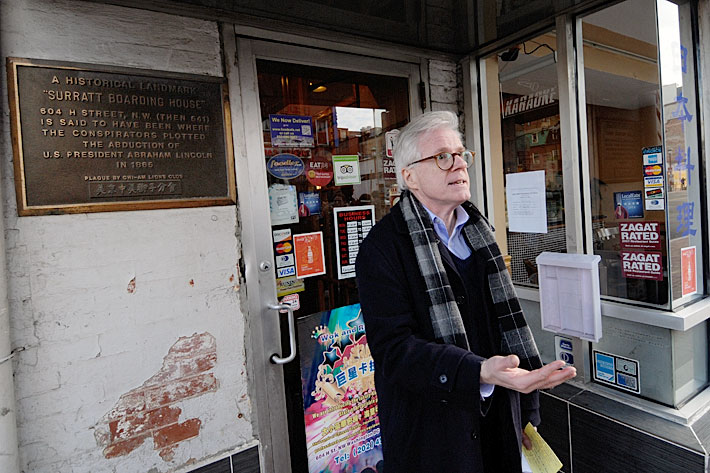 "Why isn’t the Surratt House preserved?" Dr. Mallon asks his students. "Why is the Petersen House preserved and this isn’t?" The answer is found in the way people treat history. "It's an example of the difference between fame and infamy," he said. (Rob Stewart/GW Today)
"Why isn’t the Surratt House preserved?" Dr. Mallon asks his students. "Why is the Petersen House preserved and this isn’t?" The answer is found in the way people treat history. "It's an example of the difference between fame and infamy," he said. (Rob Stewart/GW Today)
Surratt and her boarding house are examples of the difference between fame and infamy, Dr. Mallon said, and infamy should still remain part of the narrative. One-hundred-and-fifty years later, Lincoln’s assassination, he said, can become almost two-dimensional, with Lincoln and Booth, “at a vast remove,” almost equivalent figures, their profiled images side by side for eternity. They make Civil War chess sets now, he and Ms. Kidd said, and that symbolism further adds to the image of a flattened version of messy historical events.
“You remember Booth’s name and Lincoln’s name as if they are equals in what happened,” Ms. Kidd said. “They weren’t.”
The ethical component should be preserved, Dr. Mallon said. As they explore symbolism, art, media, literature—even fiction—students in “The Assassination of Lincoln” also form a fuller connection with the story, drawing closer to reality. It is important, Dr. Mallon said, to think of Lincoln and Booth as people, not just figures in a public spectacle from the past.
On April 15, he plans to ask his students to observe a moment of silence.
“Distance tends to drain the moral factor of things,” he said. “It’s very important for them to see Lincoln as a man, not a myth, who was murdered—not just a photograph in a textbook.”


